With two of the favourites to win the Women’s Euro 2022 facing off against each other in the second round of group stage matches for a spot in the knockout rounds, it was always going to be a spectacle. Both Germany and Spain had won their first matches of the tournament with this being the first look at how they match up against the top opponents. Germany were clinical to punish Spain’s mistakes to win 2-0 on the night, with tactical decisions from the two managers key to the outcome.
This article will be a tactical analysis looking at the core tactics deployed by Martina Voss-Tecklenburg’s German team to win this battle between the two titans of the women’s game, and trying to understand why Jorge Vilda’s Spain side couldn’t convert their possession into a victory.
Lineups
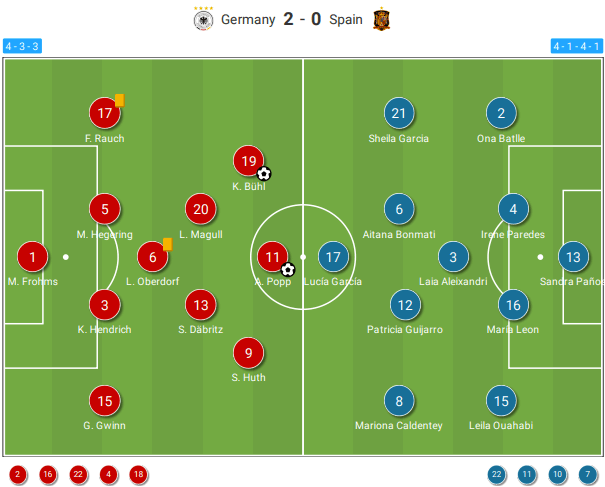
With the game being a great benchmark for the two teams for the later stages of the tournament, both managers chose the best starting lineups at their disposal. Germany made just one change to the starting lineup as, the goalscorer from the first match, Lea Schüller made way for Alexandra Popp, who also found the back of the net as she scored the final goal against Denmark in the 4-0 win. After the first half, Germany decided to change formations from their 4-3-3 to protect their two goals as they lined up with a 4-2-3-1. Five substitutes were made by Die Nationalelf as they successfully kept their second consecutive clean sheet at the Euros.
Jorge Vilda made similar changes to his starting eleven as Sheila Garcia took Esther Gonzalez’s place in attack for the side and Irene Guerrero was swapped for the more defensively-minded, Man City midfielder Laia Aleixandri. The ex-Real Madrid youth player, Jorge Vilda, also tinkered with his formation pulling back the wingers from the 4-3-3 to create a more defensive 4-1-4-1 which aided Spain’s dominance in the build-up, but may have reduced the creativity in the attack that proved important in this match.
Parking the bus
Spain were by far the more dominant side on the ball in their 2-0 defeat, having 71% possession over the entire match. Not only the possession but offensively Jorge Vilda’s side racked up over double Germany’s penalty area statistics with 32 entries and 36 touches in the box. However, only looking at the numbers can hide the true dynamic between the two sides especially when they are two giants of Europe. Therefore adding context to the key moments of the match will paint a picture of how the teams shaped up tactically in the match.
As stated before, Germany started the match in their 4-3-3 formation, the same as the Denmark match. This formation enhances Voss-Tecklenburg’s side’s pressing ability by enabling the attack to apply more pressure to the Spain defensive line from the start. The aggressive press from kick-off resulted in them capitalising on the mistake by Barcelona Femenino’s Sandra Paños, as Klara Bühl ruthlessly punished the error to put Germany ahead after only two minutes.
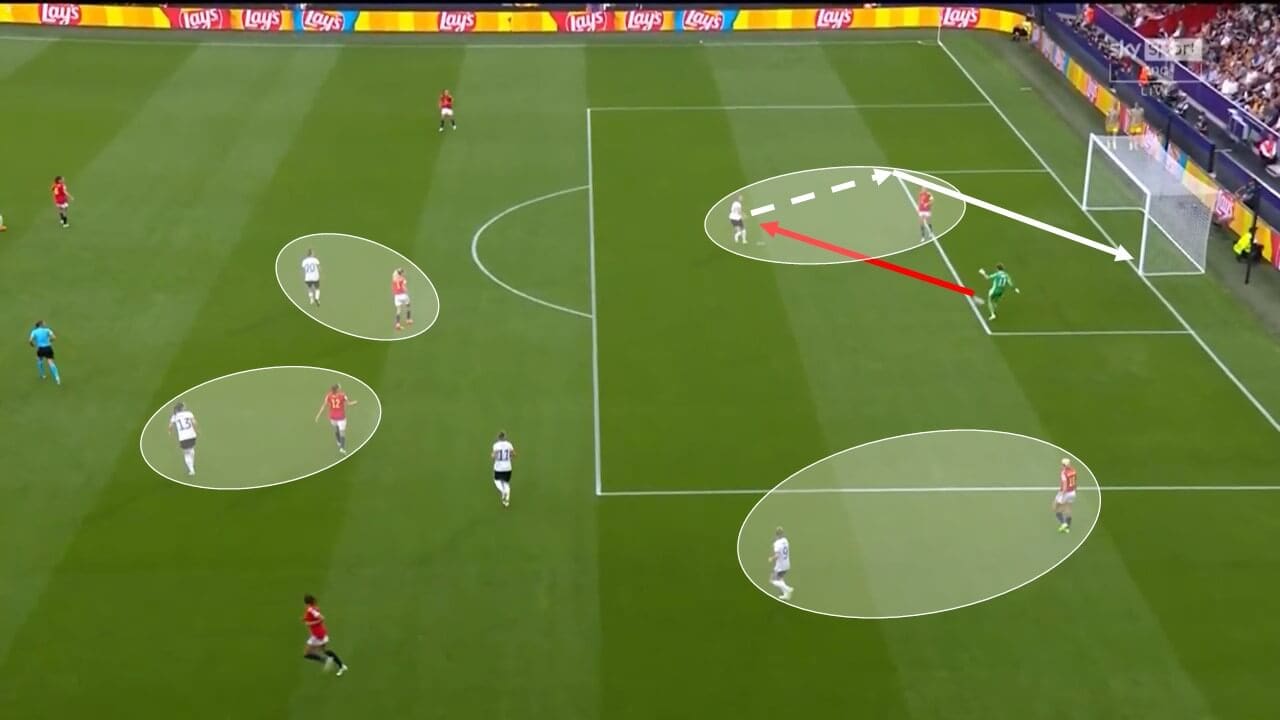
For the entire first half, in the 4-3-3 formation, Germany were equal with Spain in most of the offensive stats, higher in the defensive stats, but significantly lower in possession and passing. In terms of shots, Germany were tied with Spain as they took 5 shots each but the 2 shots on target for Germany both resulted in goals as Spain only had the 1 on target. Even in penalty box entries, La Roja couldn’t find an edge on Voss-Tecklenburg’s side as they were only separated by clinical finishing going into the first half.
The second half was a stark contrast to the German side of the first half with the formation change to a 4-2-3-1 symbolising the tactical change in the system. The 4-2-3-1 is a variation of the 4-3-3 but uses less aggressive wide players, as the wingers are now wide midfielders protecting the width lost in midfield with a double pivot screening the defence. With just this one change, Germany’s plan was clearly to hold onto their two goals as they almost nullified their own attacking output opting for defensive solidity.
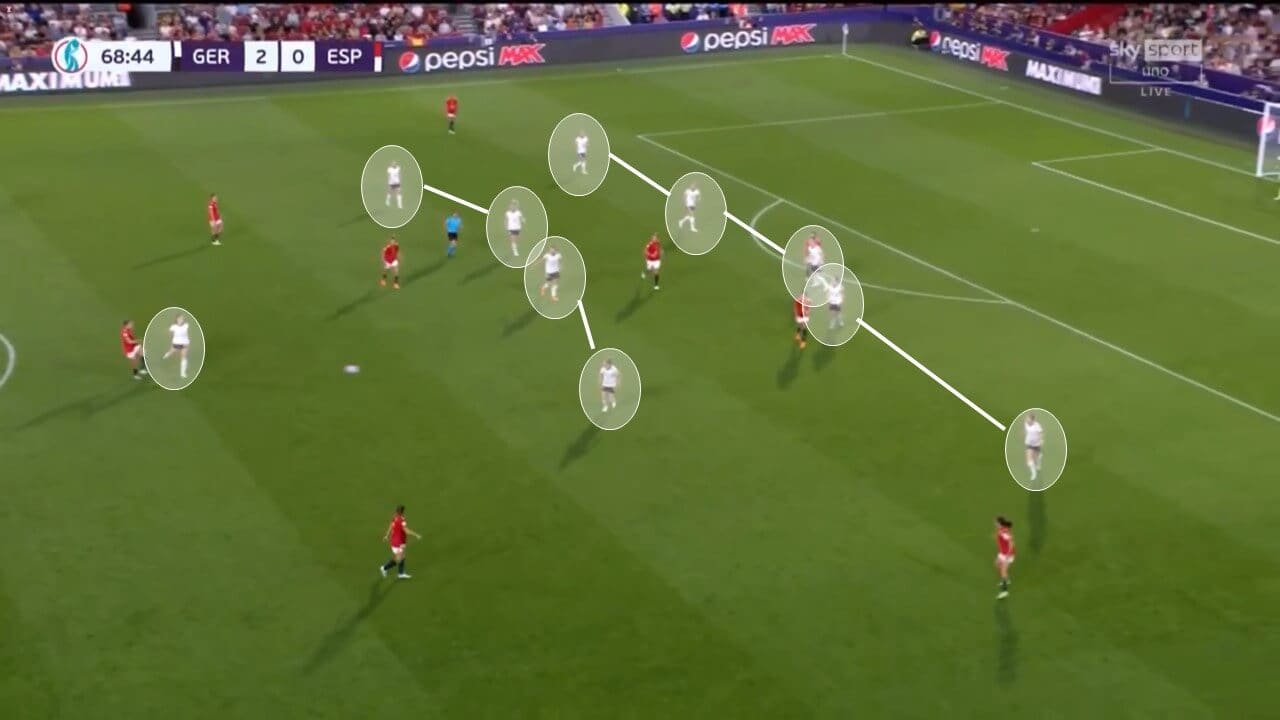
This was a bold move by Voss-Tecklenburg, getting her team to be in a 5-4-1 at times, as she knew that challenging Spain for possession would only hinder her side’s chances of a win, so sitting more compact was the other option for seeing out a win. Consequently, the German attack was almost non-existent as they entered the ex-PSG Féminine defender Irene Parades’ defensive third just 4 times across the 48 minutes, making that one final third entry every 12 minutes! Needless to say, Germany had 1 shot from outside the box in the second half and just 2 touches in Spain’s penalty area.
With the context intertwined with the numbers, it is clear why at the start it looked as though Spain had complete control of Germany over the match, pinning Die Nationalelf into their defensive third and forcing them to change their shape. Now it is clear that Germany spotted a tactical advantage they could gain over Spain to increase the likelihood of seeing themselves through to the knockout stages.
Using this tactic most definitely has its drawbacks as Spain were not limited with their time on the ball and opportunities to create chances, but when used effectively and against suitable opponents, it can be very difficult for the opposition to find a goal-scoring opportunity. Germany were street smart with the increased difficulty for Spain to create a tempo in the match, with Germany’s five substitutions placed strategically to slow down the match throughout the second half.
Germany’s Direct Attack
Along with Germany’s high press in attack, they also looked to play direct on the floor trying to break on Spain’s defence. Defensively this was a big weakness for Spain as they sent numbers forward in attack to exploit the space between Germany’s defence and middle to create chances of their own.
With Vilda’s side having so much possession of the ball without any purpose to progress forward, the risk was always losing it while the team were in an offensive shape. Germany’s relentless press from the first half was able to capitalise on the lapses in concentration, aiming to get in front of the goal in the fewest number of passes necessary. Over the entire match, Germany completed 26 long passes more than Spain’s 19 and Die Nationalelf averaged just 2.5 passes per possession, under half Spain’s 5.6.
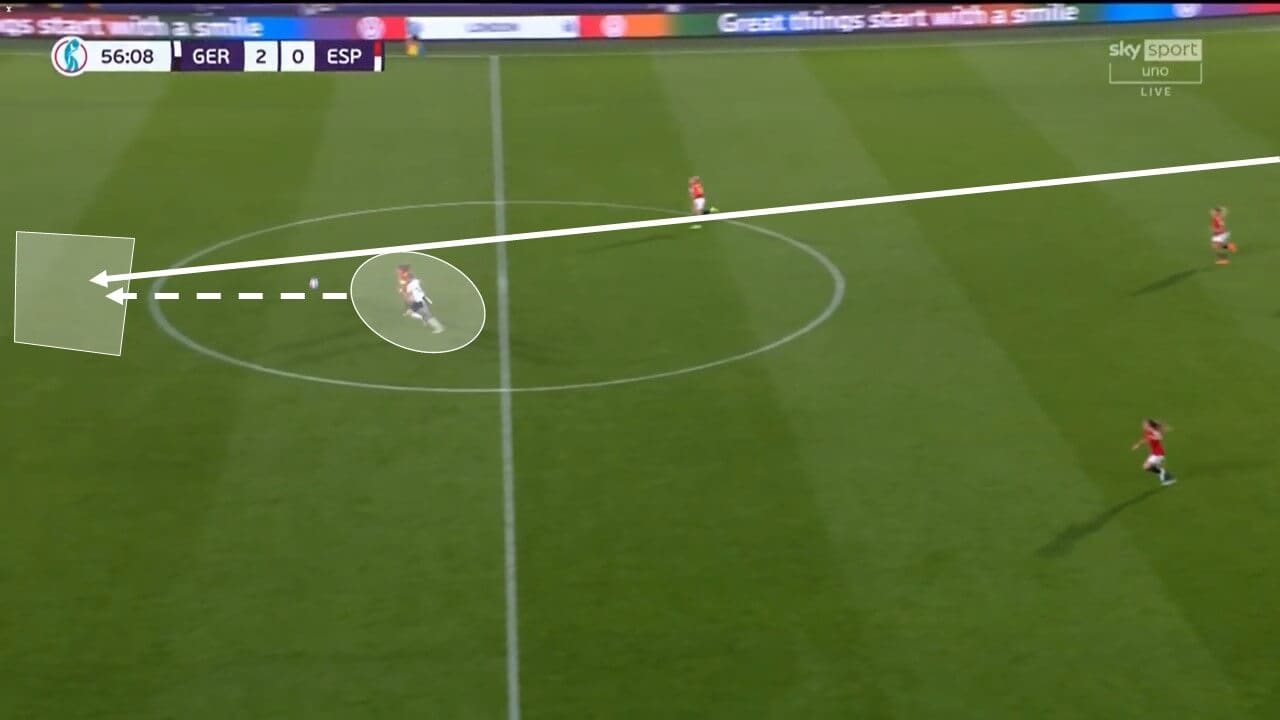
Spain struggled to get to grips with the direct play from Germany during the match relying on last-ditch tackles to stop the German attacks. In the situation above, Germany had a great shout for Parades to get sent off for a potential foul on Popp as the last defender. As Popp was ahead when chasing the ball over the top, Parades clearly pulled the German’s shirt dragging the striker to the ground. On this occasion, there was no foul but it could have been a sending-off in another match.
The attacks didn’t just look like lofted punts upfield. In the first half, they mainly involved threaded-through balls onto runs beyond the Spain defence. These were more accurate but relied on players forward to run off each other, which is not possible in a hyper-defensive shape.
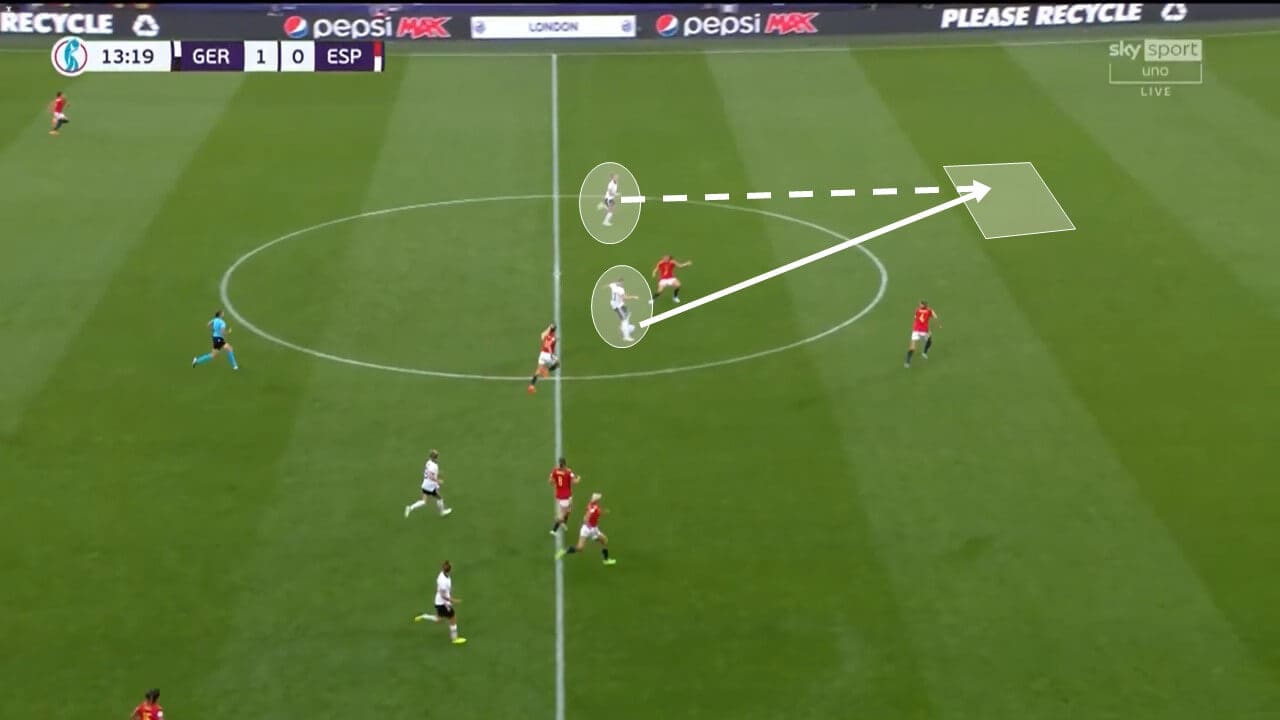
Germany executed their game plan to perfection in both halves, capitalising on Spain’s mistakes with direct play and clinical finishing, while keeping compact when defending deep in their defensive third. There is no doubt that Voss-Tecklenburg and her team had done their homework before the game.
Spain’s struggles to score
Even though Germany are of a much higher calibre than Finland, Spain’s first opponent of the tournament, the stark difference in the shots is astonishing. In the 4-1 win over Finland, Spain had 13 shots on target, more than all 11 shots they had against Germany in this match. Spain look to be struggling to create any real goalscoring opportunities in the tournament with an xG of 2.54 against Finland and 0.74 against Germany.
For all their quality, Spain look to be missing the final touch to turn possession into goals, which is hugely important for their playing style. For chance creation, La Roja turned to all types of options, from crosses, completing 17 against Germany, to penalty box runs, amounting to 9. Spain did have a few chances to pull level with Germany, the first coming in the ninth minute.
Patricia Guijarro slipped the first-time ball, while in between the lines, for Lucía García to go one-on-one with Merle Frohms, who had an impressive match in between the sticks.
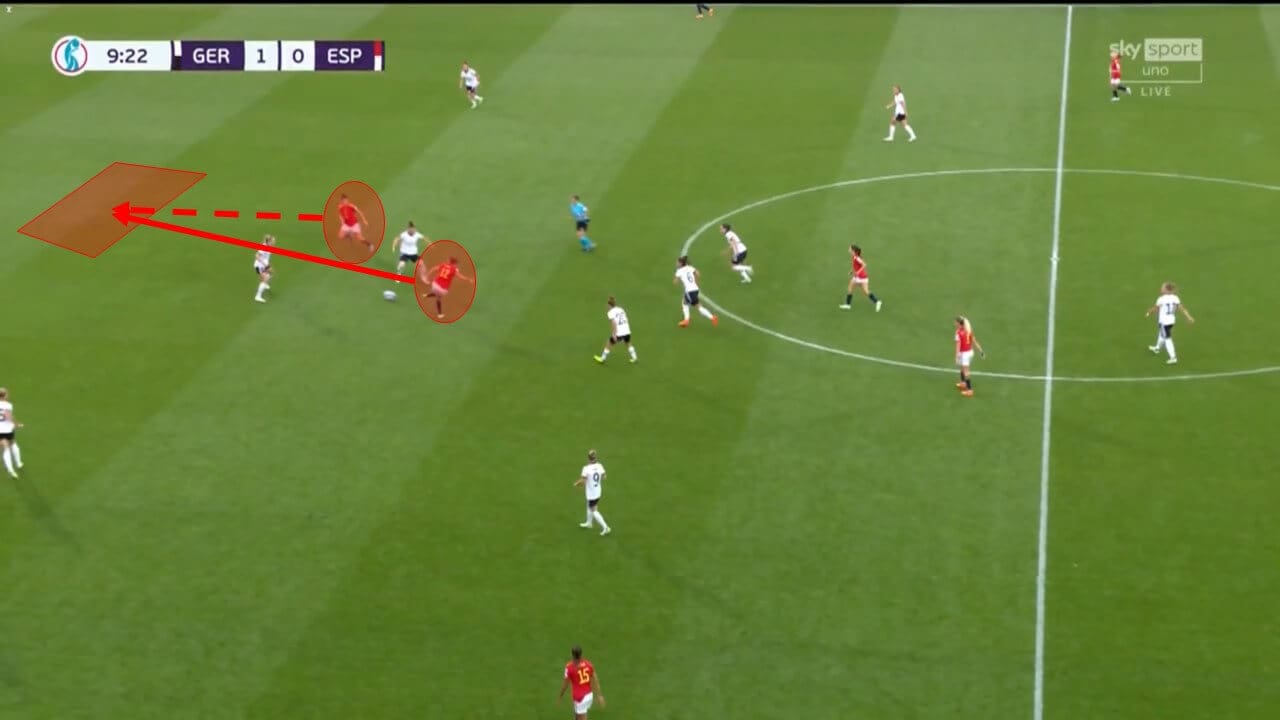
García was committed to going around the German goalkeeper, taking in away from Frohms early in the situation. After a poor touch to go around Frohms, the now narrow angle was too much for the Athletic Bilbao striker as she hit the side netting.
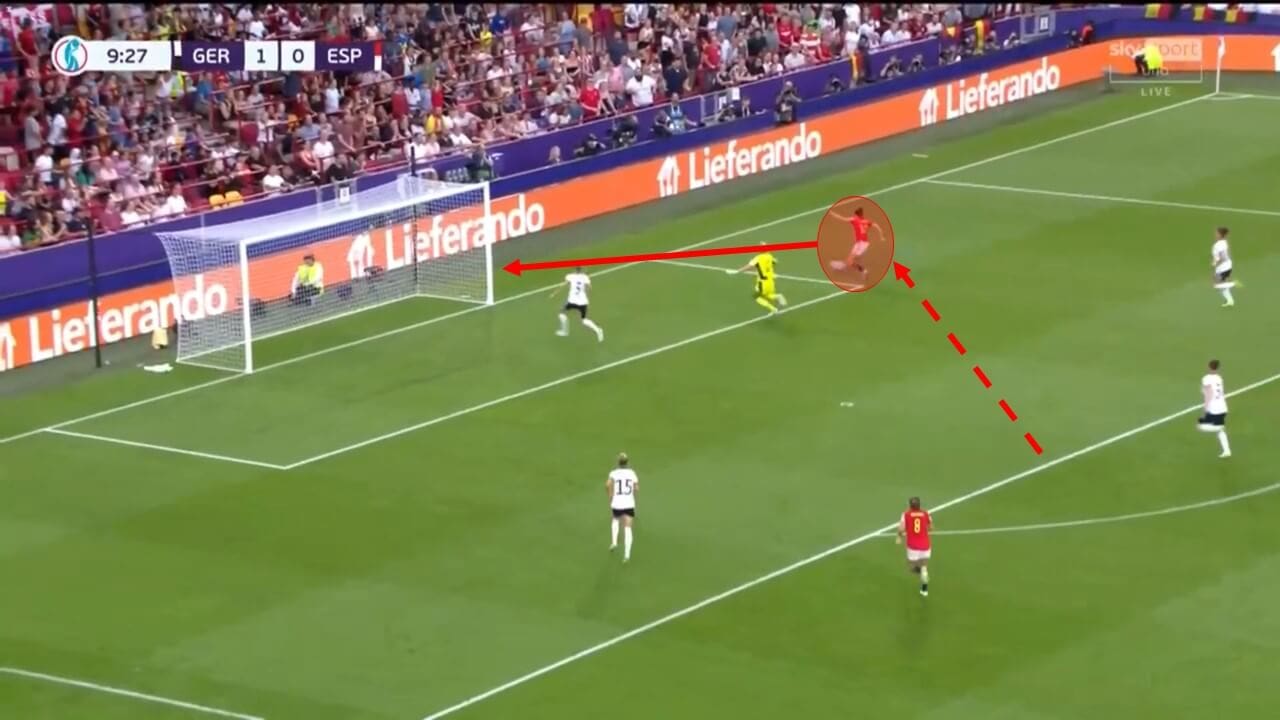
Besides, the poor touch and finish Spain had done everything right to put an opportunity on the plate for their striker only for the final details to be missing for the team. From this example, it is clear that it is not only the defensive brilliance of Germany that allowed them to keep a clean sheet but the finishing touch to Spain’s possession-based football which was missing.
Spain’s best success came with passing over or through Germany’s defence with perfectly placed through balls to pick out runs in behind, Bayern Munich Frauen’s Marina Hegering’s backline. The closest Spain got to scoring following the break was a Mariona Caldentey volley in the 70th minute. Apart from the spectacular save from Frohms, the Spanish attack exploited the compact and deep defensive shape of Voss-Tecklenburg’s side expertly. Patricia Guijarro again, has the quality and awareness to pick out a forward run from a teammate, placing the ball perfectly into the path of Caldentey.
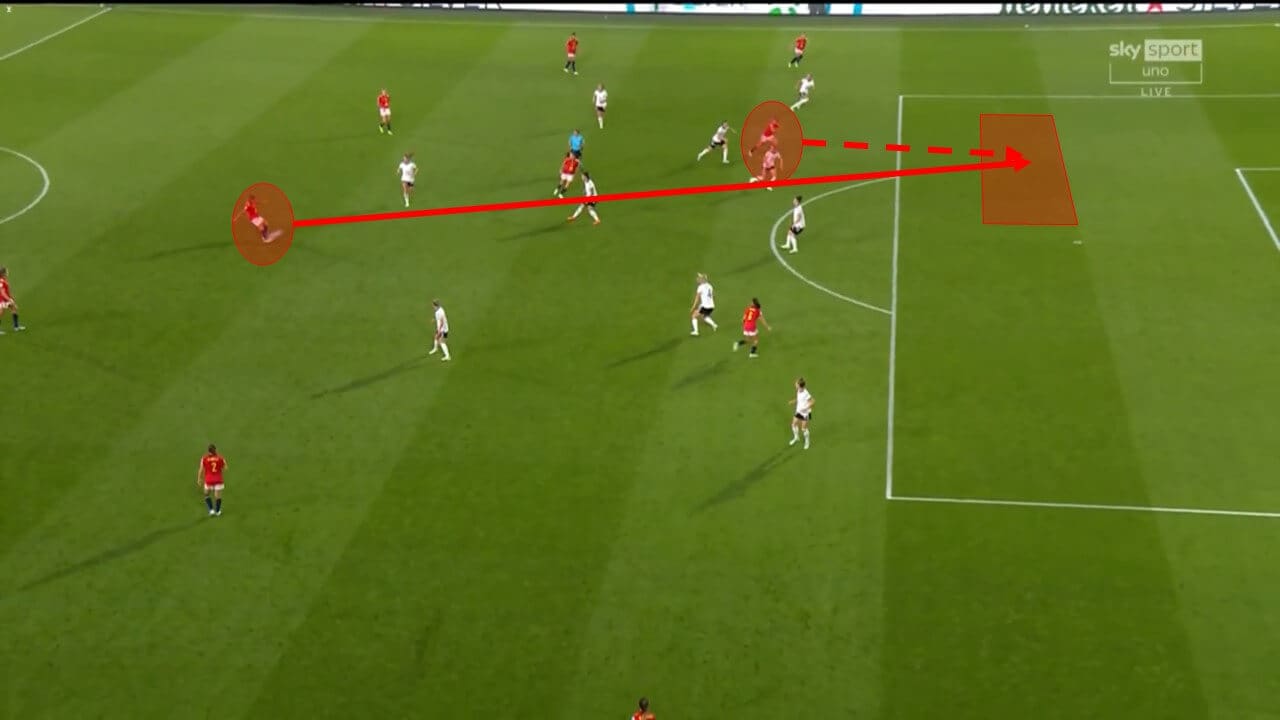
Taking the ball first time on the volley, the Barcelona Femenino forward forced perhaps the save of the tournament already from Frohms to get a strong hand to the goal-bound shot from Caldentey. This time, nothing was lacking, but Germany’s heroics to stop La Roja from scoring was the difference.
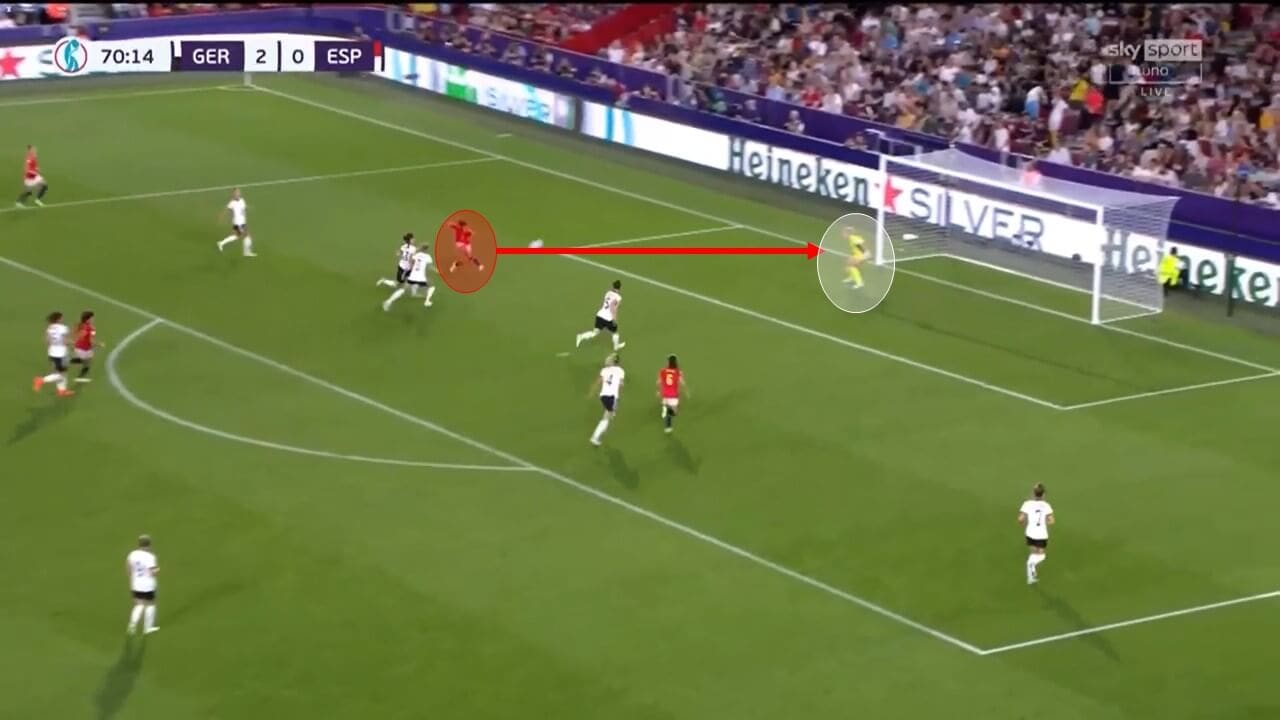
Jorge Vilda will be slightly worried that his side only mustered the 0.74 xG in the match even for all their dominance, but with this being against a strong German side, he will not have too many fears if they were to face up against each other again. For the next meeting against a strong opponent, Vilda must ensure that mistakes are at a minimum around the defensive third and that the chances created by his side are finished off with as much quality as they use to create them.
Summary
Voss-Tecklenburg was masterful with her tactics throughout the match, as shown by this analysis, spotting when to sit tight to make it harder for Spain to go through the middle of the pitch and utilising a formation change to improve the rigidity in the defensive shape for the second half. Giving Spain the space and time to play their possession-based style would be something not all teams would be comfortable doing but Germany had clearly worked on it beforehand and were comfortable giving Spain control of the ball.
Spain do not lack quality in the squad with some of the best players in the game at their disposal, so it is hard to say whether sitting deep is something that would work every time against this Jorge Vilda side. But, considering the quality within the Spanish ranks, Jorge Vilda and the squad will be disappointed to have not converted any of their chances into goals.
Next for Spain is Denmark as the two teams battle it out to progress to the knockout stages.






Comments